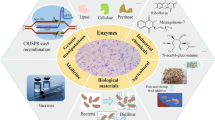Abstract
Bacterial reporter assays are powerful tools used to study the effect of different compounds that affect the physiology of cellular processes. Most bacterial reporters are luciferase based and can be monitored in real time. In the present study we designed and implemented two sets of Escherichia coli bacterial reporter assays, using a multicopy plasmid system. Each reporter strain was constructed using either green fluorescent protein or β-galactosidase (LacZ) proteins. The designed reporter strains are capable of responding in a specific manner to molecules that either oxidative stress, or membrane, protein, or DNA damage. In order to respond to the desired stimulus, promoter sequences from E. coli were used. These sequences correspond to the promoter of the major catalase (KatG) activated with cellular oxidative damage, the promoter of the β-hydroxydecanoyl-ACP dehydrase (FabA) which is activated with membrane perturbation, the promoter of DNA recombinase (RecA) which is activated by DNA lesions. For protein misfolding, the promoter of the heat-shock responsive chaperon (DnaK) was used. Our constructs displayed activation to damage from specific stimuli, and low response to nonspecific stimuli was detected. Our results suggest that these types of bacterial reporter strains can be used in semiquantitative (fluorometric) and qualitative (β-galactosidase activity) studies of different xenobiotic substances and pollutants.



Similar content being viewed by others
References
Bechor O, Smulski DR, Van Dyk TK, LaRossa RA, Belkin S (2002) Recombinant microorganisms as environmental biosensors: pollutants detection by Escherichia coli bearing fabA’: lux fusions. J Biotechnol 94:125–132
Belkin S, Smulski DR, Vollmer AC, Van Dyk TK, LaRossa RA (1996) Oxidative stress detection with Escherichia coli harboring a katG’: lux fusion. Appl Environ Microbiol 62:2252–2256
Crameri A, Whitehorn EA, Tate E, Stemmer WP (1996) Improved green fluorescent protein by molecular evolution using DNA shuffling. Nat Biotechnol 14(3):315–319
Daunert S, Barrett G, Feliciano JS, Shetty RS, Shrestha S, Smith-Spencer W (2000) Genetically engineered whole-cell sensing systems: coupling biological recognition with reporter genes. Chem Rev 100(7):2705–2738
De Flora S, Camoirano A, Zanacchi P, Bennicelli C (1984) Mutagenicity testing with TA97 and TA102 of 30 DNA-damaging compounds, negative with other Salmonella strains. Mutat Res 134(2–3):159–165
Gu M, Mitchell RJ, Kim BC (2004) Whole-cell-based biosensors for environmental biomonitoring and application. Adv Biochem Eng Biotechnol 87:269–305
Imlay JA (2013) The molecular mechanisms and physiological consequences of oxidative stress: lessons from a model bacterium. Nat Rev Microbiol 11:443–454
Jones AM, Grossmann G, Danielson JÅ, Sosso D, Chen LQ, Ho CH, Frommer WB (2013) In vivo biochemistry: applications for small molecule biosensors in plant biology. Curr Opin Plant Biol 16:89–95
Kohlmeier S, Mancuso M, Tecon R, Harms H, van der Meer JR, Wells M (2007) Bioreporters: gfp versus lux revisited and single-cell response. Biosens Bioelectron 22:1578–1585
Lu C, Albano CR, Bentley WE, Rao G (2005) Quantitative and kinetic study of oxidative stress regulons using green fluorescent protein. Biotechnol Bioeng 89(5):574–587
Neidhardt FC, VanBogelen RA (1987) Heat shock response. In: Neidhardt FC, Ingraham JL, Low KB, Magasanik B, Schaechter M, Umbarger HE (eds) Escherichia coli and Salmonella typhimurium: cellular and molecular biology. American Society for Microbiology, Washington, pp 1334–1345
Park SC, Lim JY, Jeen YT, Keum B, Seo YS, Kim YS, Lee SJ, Lee HS, Chun HJ, Um SH, Kim CD, Ryu HS, Sul D, Oh E (2012) Ethanol-induced DNA damage and repair-related molecules in human intestinal epithelial Caco-2 cells. Mol Med Rep. 5(4):1027–1032
Raut N, O’Connor G, Pasini P, Daunert S (2012) Engineered cells as biosensing systems in biomedical analysis. Anal Bioanal Chem 402:3147–3159
Robbens J, Dardenne F, Devriese L, CoenW De, Blust R (2010) Escherichia coli as a bioreporter in ecotoxicology. Appl Microbiol Biotechnol 88:1007–1025
Roelant CH, Burns DA, Scheirer W (1996) Accelerating the pace of luciferase reporter gene assays. Biotechniques 20:914–917
Sambrook J, Russell DW (eds) (2001) molecular cloning: a laboratory manual, 3rd edn. Cold Spring Harbor Laboratory, New York
Truffer F, Buffi N, Merulla D, Beggah S, van Lintel H, Renaud P, van der Meer JR, Geiser M (2014) Compact portable biosensor for arsenic detection in aqueous samples with Escherichia coli bioreporter cells. Rev Sci Instrum 85:015120. doi:10.1063/1.4863333
Van Dyk TK, Majarian WR, Konstantinov KB, Young RM, Dhurjati PS, LaRossa RA (1994) Rapid and sensitive pollutant detection by induction of heat shock gene-bioluminescence gene fusions. Appl Environ Microbiol 60:1414–1420
Vangnai AS, Kataoka N, Soonglerdsongpha S, Kalambaheti C, Tajima T, Kato J (2012) Construction and application of an Escherichia coli bioreporter for aniline and chloroaniline detection. J Ind Microbiol Biotechnol 39:1801–1810
Vollmer AC, Belkin S, Smulski DR, Van Dyk TK, LaRossa RA (1997) Detection of DNA damage by use of Escherichia coli carrying recA’: lux, uvrA’: lux, or alkA’: lux reporter plasmids. Appl Environ Microbiol 63:2566–2571
Wakayama Y, Takagi M, Yano K (1984) Gene responsible for protecting Escherichia coli from sodium dodecyl sulfate and toluidine blue plus light. J Bacteriol 159:527–532
Acknowledgments
The authors would like to acknowledge CONACyT (Grant Number CB-2012-01 182671), Promep-SEP (Grant Number F-PROMEP-38/Rev-03 SEP-23-005) and University of Guanajuato (Grant Number FO-DAI-05) for financial support. We thank Dr. Elizabeth Rodriguez-Salinas for critically reading the manuscript. We acknowledge Dr. Laura Ongay and Guadalupe Códiz at the Molecular Biology Unit at IFC, UNAM, for plasmid sequencing.
Conflict of interest
The authors declare no commercial or financial conflict of interest.
Author information
Authors and Affiliations
Corresponding author
Additional information
Communicated by Erko Stackebrandt.
Rights and permissions
About this article
Cite this article
Padilla-Martínez, F., Carrizosa-Villegas, L.A., Rangel-Serrano, Á. et al. Cell damage detection using Escherichia coli reporter plasmids: fluorescent and colorimetric assays. Arch Microbiol 197, 815–821 (2015). https://doi.org/10.1007/s00203-015-1119-y
Received:
Revised:
Accepted:
Published:
Issue Date:
DOI: https://doi.org/10.1007/s00203-015-1119-y




